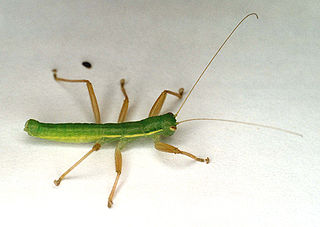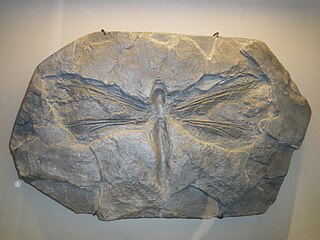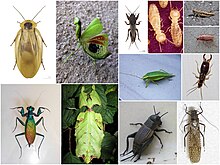
Mantophasmatidae is a family of carnivorous wingless insects within the monotypic order Mantophasmatodea, which was discovered in Africa in 2001. Recent evidence indicates a sister group relationship with Grylloblattidae, and Arillo and Engel have combined the two groups into a single order, Notoptera, with Grylloblattodea and Mantophasmatodea ranked as suborders.

Grylloblattidae, commonly known as the icebugs or ice crawlers, is a family of extremophile (psychrophile) and wingless insects that live in the cold on top of mountains and the edges of glaciers. It is the only member of Grylloblattodea, which is generally considered an order. Alternatively, Grylloblattodea, along with Mantophasmatodea, have been ranked as suborders of the order Notoptera. Grylloblattids are wingless insects mostly less than 3 cm long, with a head resembling that of a cockroach, with long antennae and having elongated cerci arising from the tip of their abdomen. They cannot tolerate warmth and many species have small distribution ranges.

Neoptera is a classification group that includes most orders of the winged insects, specifically those that can flex their wings over their abdomens. This is in contrast with the more basal orders of winged insects, which are unable to flex their wings in this way.

Dictyoptera is an insect superorder that includes two extant orders of polyneopterous insects: the order Blattodea and the order Mantodea (mantises). All modern Dictyoptera have short ovipositors and typically lay oothecae. The oldest fossils of Dictyoptera from the Late Carboniferous, referred to as "roachoids" have long ovipositors and did not lay oothecae. The oldest modern oothecae-laying dictyopterans date to the Late Triassic.

The family Prophalangopsidae are insects belonging to the order Orthoptera. They are the only extant members of the superfamily Hagloidea. There is only one extant genus in North America, where they are known as grigs, four genera in Asia, and many extinct genera.

The Exopterygota, also known as Hemimetabola, are a superorder of insects of the subclass Pterygota in the infraclass Neoptera, in which the young resemble adults but have externally developing wings. They undergo a modest change between immature and adult, without going through a pupal stage. The nymphs develop gradually into adults through a process of moulting.

Ensifera is a suborder of insects that includes the various types of crickets and their allies including: true crickets, camel crickets, bush crickets or katydids, grigs, weta and Cooloola monsters. This and the suborder Caelifera make up the order Orthoptera. Ensifera is believed to be a more ancient group than Caelifera, with its origins in the Carboniferous period, the split having occurred at the end of the Permian period. Unlike the Caelifera, the Ensifera contain numerous members that are partially carnivorous, feeding on other insects, as well as plants.
Michael S. Engel, FLS, FRES is an American paleontologist and entomologist, notable for contributions to insect evolutionary biology and classification. In connection with his studies he has undertaken field expeditions in Central Asia, Asia Minor, the Levant, Arabia, eastern Africa, the high Arctic, and South and North America, and has published more than 925 papers in scientific journals.Some of Engel's research images were included in exhibitions on the aesthetic value of scientific imagery.
Glosselytrodea is an extinct order of insects, containing about thirty species. Its fossil record dates from the Permian to the Upper Jurassic, and is distributed across Eurasia, the Americas, and Australia. Its classification is uncertain, but may be closely related to Neuropterida or Orthoptera.

The wingless insect superorder Notoptera, a group first proposed in 1915, had been largely unrecognized since its original conception, until resurrected in 2004. As now defined, the superorder comprises five families, three of them known only from fossils, two known from both fossil and living representatives, and fewer than 60 known species in total.

Edmund Murton Walker was a Canadian entomologist. He described the genus Grylloblatta in 1914 which he then considered as a member of the Orthoptera and later placed it in a separate order Grylloblattodea but which are now included in the order Notoptera.
Orthopteroids are insects which historically would have been included in the order Orthoptera and now may be placed in the Polyneoptera. When Carl Linnaeus started applying binomial names to animals in the 10th edition of his Systema Naturae in 1758, there were few animals included in the scheme, and consequently few groups. As more and more new species were discovered and differences recognised, the original groups proposed by Linnaeus were split up.
Zdenekia is a genus of extinct winged insects from the Upper Carboniferous period. It contains the species Z. grandis from the Czech Republic, Z. occidentalis from Belgium, and Z. silesiensis from Poland. Zdenekia is considered a member of the extinct order Paoliida, a group that historically had controversial affinities and composition but have been resolved as the sister group of Dictyoptera by recent studies.

Chresmodidae is an extinct family of Mesozoic insects within the superorder Polyneoptera.

Meganeuridae is an extinct family of griffinfly in the order Meganisoptera. There are more than 20 genera and 50 described species in Meganeuridae. This family of flies contain the genus Meganeuropsis, which has one of the biggest animals in the world, Meganeuropsis permiana. This species of fly had the longest insect wing ever found.
Palaeocixiidae is an extinct family of rock crawlers in the order Grylloblattodea. There is one genus, Palaeocixius, in Palaeocixiidae.

Elcanidae are an extinct family of Mesozoic and early Cenozoic orthopterans. Members of the family are distinguished by the presence of spurs on the distal part of the metatibia, unique among orthopterans, these have been suggested to have been used for controlling gliding, swimming aids, or for jumping on water. The group combines characteristics from both major groups of orthopterans, with long antennae and nymphal morphology similar to Ensifera, but with wing venation and adult morphology more similar to Caelifera. Elcanidae is part of Elcanoidea, which is thought to have diverged from living orthopterans by the beginning of the Permian, around 300 million years ago. The family also includes Permelcanidae, known from the Early-Late Permian. The relationship of Elcanoidea to Ensifera and Caelifera is currently unresolved. Elcanids are known from the Late Triassic to Paleocene of Eurasia, North and South America. Some members of the group exhibited aposematic coloration.
Geinitziidae is an extinct family of polyneopteran insects, known from the Permian to Cretaceous. They are currently considered to be members "Grylloblattida" a poorly defined group of extinct insects thought to be related to modern ice crawlers (Grylloblattidae). Other authors place them in the extinct order Reculida. Unlike modern ice crawlers, which are wingless, they had large wings, bearing a superficial resemblance to cockroaches, and are thought to have been day-active above ground predators.
Polyorthoptera is an outdated(?) magnorder of insects within the cohort polyneoptera that includes Dermaptera Grylloblattodea Mantophasmatodea Phasmatodea and Orthoptera. It is also sometimes used as a synonym for the Polyneoptera in general.

Paoliida is an extinct order of winged insects that lived in the late Paleozoic. Historically, both their systematic position and composition were controversial – for instance they had been considered as palaeodictyopterans, as basal Neoptera, or as stem-group of Pterygota – but recent studies have resolved them as the sister group of Dictyoptera.












